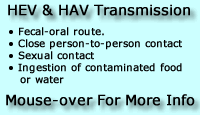Food-borne hepatitis: Hepatitis A and E
 HAV and HEV are both forms of food-borne hepatitis. Hepatitis A virus (HAV) is responsible for the majority of viral outbreaks of food origin worldwide, while hepatitis E virus (HEV) has also been gaining prominence as a foodborne viral agent in the last years, due to its zoonotic transmission through the consumption of uncooked or undercooked infected meat or derivatives.
HAV and HEV are both forms of food-borne hepatitis. Hepatitis A virus (HAV) is responsible for the majority of viral outbreaks of food origin worldwide, while hepatitis E virus (HEV) has also been gaining prominence as a foodborne viral agent in the last years, due to its zoonotic transmission through the consumption of uncooked or undercooked infected meat or derivatives.
These forms of hepatitis are spread by the fecal-oral route, usually through contaminated food, water, or shellfish, or through oral-anal sexual practices. Most cases of HAV are subclinical. Symptomatic patients may experience low-grade fever, fatigue, nausea, anorexia, myalgia, and malaise, followed by dark urine, light stools, and right upper quadrant discomfort. Liver function tests are elevated, and the patient may develop jaundice and hepatomegaly. Fortunately, HAV does not lead to a chronic infection or a carrier state and is rarely fatal. Most patients recover after a period of rest; however, up to 5% of patients may develop a protracted cholestatic hepatitis characterized by an elevated alkaline phosphatase and jaundice.
Prevention measures for HAV include washing hands before eating or preparing food, after using the bathroom, and after changing a diaper or cleaning surfaces contaminated with feces, such as a diaper-changing table. Avoiding eating raw uncooked shellfish is another personal health measure that can help prevent transmission of HAV. Individuals who are exposed to HAV and who have not received HAV vaccine should receive prophylactic doses of immune globulin, which provides passive immunity for 2 to 3 months.
Hepatitis E (HEV) is an enterically transmitted form of hepatitis transmitted by fecal-oral contact or contaminated food and water and is most prevalent in regions with poor sanitation systems. Most cases of HEV are traced to fecally contaminated water. This form of hepatitis is rare in the United States and tends to be seen in travelers returning from areas in developing countries where there are epidemics or outbreaks of HEV. The symptoms of HEV are similar to those of HAV. HEV does not produce chronic infection or a carrier state; however, liver failure can occur in pregnant women who contract this form of hepatitis. Individuals traveling to areas where HEV is prevalent can reduce their chance of infection by drinking only boiled, bottled, or properly treated water, avoiding uncooked shellfish or raw fruits and vegetables that haven't been peeled, and avoiding swimming in potentially contaminated water.
© RnCeus.com
 HAV and HEV are both forms of food-borne hepatitis. Hepatitis A virus (HAV) is responsible for the majority of viral outbreaks of food origin worldwide, while hepatitis E virus (HEV) has also been gaining prominence as a foodborne viral agent in the last years, due to its zoonotic transmission through the consumption of uncooked or undercooked infected meat or derivatives.
HAV and HEV are both forms of food-borne hepatitis. Hepatitis A virus (HAV) is responsible for the majority of viral outbreaks of food origin worldwide, while hepatitis E virus (HEV) has also been gaining prominence as a foodborne viral agent in the last years, due to its zoonotic transmission through the consumption of uncooked or undercooked infected meat or derivatives.